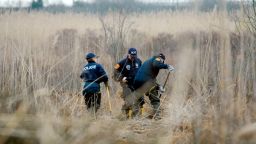Editor’s Note: This story includes graphic descriptions some readers may find disturbing.
Gilgo Beach serial killings suspect Rex Heuermann now faces charges in the deaths of six women spanning three decades and multiple Long Island communities after he was indicted on two new murder charges Thursday — the latest development in an investigation authorities in New York say is far from over.
Heuermann pleaded not guilty to charges of second-degree murder in the 2003 death of Jessica Taylor and the 1993 death of Sandra Costilla.
The 60-year-old architect was taken by surprise by Thursday’s charges, and he is “in a bad place in terms of the new charges,” his attorney Michael Brown said after his client appeared in an eastern Long Island courtroom. Heuermann was remanded without bail and is expected in court July 30.
“One murder is obviously horrific, and it’s a difficult thing to defend,” Brown said. “And now we’re at six,” Brown said.
Gasps were heard in the courtroom as Suffolk County prosecutor Nicholas Santomartino described the disturbing content he said authorities discovered on Heuermann’s devices, including a planning document outlining a strategy for future killings.
A Word document Heuermann allegedly created on a laptop in 2000 and modified over several years outlines how to dispose of a body, avoid apprehension and not leave DNA evidence, along with what supplies may be needed to carry out serial murder, according to the bail application.
A section called “body prep” detailed steps to clean, dismember and transport bodies, while a “post event” section of the document appeared to be a checklist of tasks to avoid apprehension, including having a story set, according to the bail application.
“This was a planning document used by Heuermann to methodically blueprint and plan out his kills with excruciating detail. His intent was specifically to locate these victims, hunt them down to bring them under his control and to kill them,” Suffolk County District Attorney Raymond Tierney said in a news conference after the court appearance.
Other evidence “revealed Heuermann’s significant collection of violent, bondage, and torture pornography, currently dating back to 1994,” the bail application reads.
Taylor’s remains were discovered in part in Manorville in 2003, with more found along Ocean Parkway on Gilgo Beach in 2011. Manorville is around 45 miles northeast of Gilgo and about 40 miles east of Massapequa Park, Heuermann’s hometown.
Her remains were found face up, decapitated, with her hands and arms severed below the elbows. A tattoo had been obliterated with a sharp object, Tierney said.
Taylor was working as a sex worker in New York City when she went missing, and officials know Heuermann was in the city the last day Taylor was seen there, he added.
When Taylor failed to return home for her mom’s birthday, her family alerted law enforcement and some of her body was recovered the next day. Witnesses said they saw a dark-colored pickup near where her body was eventually recovered, according to the bail application.

Costilla’s remains were found in North Sea in 1993 by two hunters in the woods, according to the bail application.
She was found on her back, with 25 sharp force injuries believed to have been imposed post-mortem, Tierney said.
Forensic testing performed on strands of hair found on or near both Taylor and Costilla’s remains found that the 99.96% of the North American population could be excluded as the source of the hairs – but Heuermann could not.
The bail application highlights that two different forensic laboratories determined hairs recovered on five of the six charged victims were tied to Heuermann, members of his immediate family or to people he lived with, according to the document.
“Defendant Heuermann is the individual who murdered, stripped, restrained, and transported the remains of Jessica Taylor and Sandra Costilla, as well as the Gilgo Four, until they were each discovered in 1993, 2003, 2010, and 2011,” the bail application reads.
Heuermann was initially arrested in July 2023 and was charged with murder in the killings of four women whose bodies were discovered bound with belts or tape and wrapped in burlap along a stretch of Long Island’s Gilgo Beach in 2010.
Those victims – Melissa Barthelemy, Megan Waterman, Amber Costello and Maureen Brainard-Barnes – became known as the “Gilgo Four.” Heuermann pleaded not guilty to the charges related to all four.
The women were among at least 11 sets of remains discovered near the waterfront in Long Island’s Suffolk County since 2010.
Authorities have accused Heuermann of leading a double life, with his wife and children away for most of the alleged murders.

That allegedly allowed Heuermann “unfettered time to execute his plans for each victim without any fear that his family would uncover or learn of his involvement in these crimes,” prosecutors previously said in an indictment.
Less than a week after Heuermann’s arrest, his wife filed for divorce. But she has since said she does not believe Heuermann is capable of the alleged crimes.
In January, Brown told reporters the former New York architect claimed he’s “not guilty of these charges” and looks forward to fighting the charges in court.
‘We are not near the end of this investigation,’ law enforcement source says
Tierney announced Thursday that investigators have discovered a plethora of new evidence at Heuermann’s Massapequa Park house, including cameras, computers, hard drives, cell phones and other devices.
Detectives believe, based on “offender characteristics” of serial killers, there may be more alleged killings, according to officials briefed on the investigation.
“In most of these cases, a serial killer does not start killing in his 40s,” said a law enforcement official familiar with the case.
That belief spurred investigators to not only expand their attempts to identify unidentified victims, re-examine dump sites and conduct additional searches of Heuermann’s home, but to also begin reexamining unsolved missing persons cases.
Investigators are also looking at seemingly unrelated unsolved homicides where there may be similarities among the victims, the crime scenes or condition of the bodies.
“We are not near the end of this investigation,” one law enforcement official involved in the sweeping case said. “We are very much at the beginning.”
CNN’s John Miller, Emma Tucker and Ray Sanchez contributed to this report.










